This Week’s Sky at a Glance, February 26 – March 5
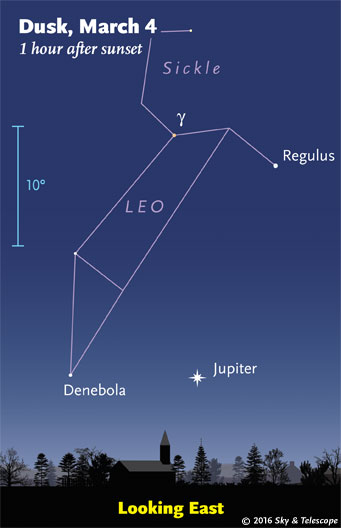

Jupiter is almost at opposition! All week, it's already up in the east when twilight fades. As night comes on, you'll find Leo striding above it. (The blue 10° scale is about the width of your fist at arm's length.)
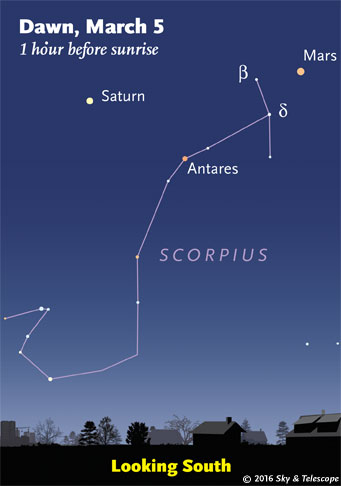
Meanwhile in the dawn all week, Saturn and Mars stand over Scorpius.
Friday, February 26
• After dinnertime at this time of year, four carnivore constellations stand upright in a row from the northeast to south. They're all seen in profile with their noses pointed up and their feet (if any) to the right. These are Ursa Major in the northeast (with the Big Dipper as its brightest part), Leo in the east, Hydra the Sea Serpent in the southeast, and bright Canis Major in the south.
Saturday, February 27
• It's a busy night at Jupiter. First, Europa disappears into eclipse by Jupiter's shadow at 9:03 p.m. EST, just barely off Jupiter's celestial western limb. Five minutes later, Ganymede emerges from behind the opposite limb! If Jupiter is up in view yet where you are, watch at just the right time to catch this seeming switcheroo.
Later, the tiny black shadow of Jupiter's moon Io crosses Jupiter's face from 11:06 p.m. to 1:21 a.m. EST, with Io itself following along just 13 minutes behind. In the midst of that, Europa reappears from behind Jupiter's eastern limb at 1:14 a.m. EST. (Subtract 3 hours to get Pacific Standard Time.)
Sunday, February 28
• The Moon, nearly last-quarter, rises around midnight. Mars follows it up about 5° below it. By dawn on Monday the 29th, they stand in the south.
Monday, February 29
• Before and during dawn tomorrow morning, the waning Moon makes a quadrilateral with Mars to its left, Saturn to its right, and Antares below it.
Tuesday, March 1
• Look east after dark this week for the constellation Leo already climbing well up the sky. His hind foot is on bright Jupiter. Leo's brightest star is Regulus, and the Sickle of Leo extends upper left from there. As the saying goes, Leo announces spring.
• Last-quarter Moon (exact at 6:11 p.m. EST). The Moon rises in tandem with Saturn around 1 or 2 a.m. tonight and shines left of Saturn during early dawn on Wednesday the 2nd.
Wednesday, March 2
• This is a fine week to look for the zodiacal light if you live in the mid-northern latitudes. At a clear, dark site, look west at the very end of twilight for a vague but huge, tall pyramid of pearly light. It's tilted left to align along the constellations of the zodiac. What you're seeing is sunlit interplanetary dust orbiting the Sun near the ecliptic plane. Believe it or not, seen from interstellar distances this would be the solar system's most prominent feature after the Sun itself. The "zodiacal lights" of dust around other stars may be a real obstacle to someday seeing their small, terrestrial planets.
Thursday, March 3
• Have you ever seen Canopus, the second-brightest star after Sirius? Canopus lies almost due south of Sirius: by 36°. That's far enough south that it never appears above your horizon unless you're below latitude 37° N (southern Virginia, southern Missouri, central California). And there you'll need a flat south horizon. Canopus crosses the south point on the horizon just 21 minutes before Sirius does.
When to look? Canopus is due south when Beta Canis Majoris — Mirzim the Announcer, the star a few finger-widths to the right of Sirius — is at its highest point due south (about 7 or 8 p.m. now, depending on how far east or west you are in your time zone). Look straight down from Mirzim then.
Friday, March 4
• The Big Dipper glitters high in the northeast these evenings, standing on its handle. You probably know that the two stars forming the front of the Dipper's bowl (currently on top) are the Pointers; they point to Polaris, currently to their left.
And, you may know that if you follow the curve of the Dipper's handle out and around by a little more than a Dipper length, you'll arc to Arcturus, now rising in the east.
But did you know that if you follow the Pointers backward the opposite way, you'll land in Leo?
Draw a line diagonally across the Dipper's bowl from where the handle is attached, continue far on, and you'll go to Gemini.
And look at the two stars forming the open top of the Dipper's bowl. Follow this line past the bowl's lip far across the sky, and you crash into Capella.
Saturday, March 5
• On the traditional divide between the winter and spring sky is the dim constellation Cancer. It's between Gemini to its west and Leo to its east. Cancer has a unique feature: the Beehive Star Cluster, M44, in its middle. The Beehive shows to the naked eye only if your light pollution is slight. Look for it a little less than halfway from Pollux to Regulus. With binoculars it's a snap.
__________________________
Want to become a better astronomer? Learn your way around the constellations. They're the key to locating everything fainter and deeper to hunt with binoculars or a telescope.
This is an outdoor nature hobby. For an easy-to-use constellation guide covering the whole evening sky, use the big monthly map in the center of each issue of Sky & Telescope, the essential guide to astronomy.
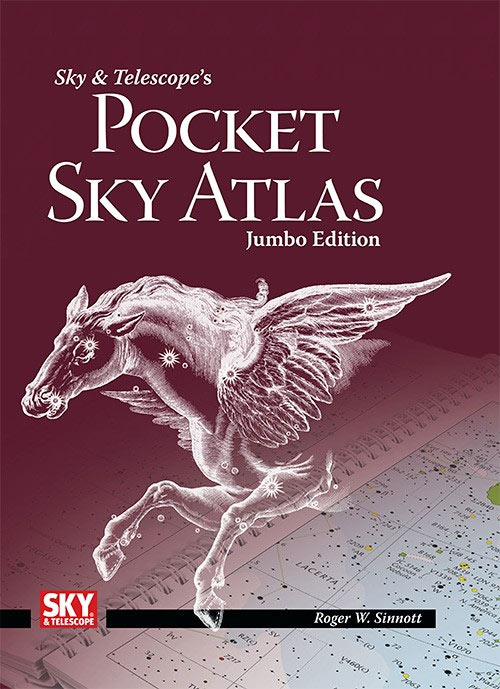
The Pocket Sky Atlas plots 30,796 stars to magnitude 7.6 — which may sound like a lot, but it's less than one per square degree on the sky. Also plotted are many hundreds of telescopic galaxies, star clusters, and nebulae. Shown above is the new Jumbo Edition for easier reading in the night. Click image for larger view.
Once you get a telescope, to put it to good use you'll need a detailed, large-scale sky atlas (set of charts). The basic standard is the Pocket Sky Atlas (in either the original or new Jumbo Edition), which shows stars to magnitude 7.6.
Next up is the larger and deeper Sky Atlas 2000.0, plotting stars to magnitude 8.5, nearly three times as many. Next up, once you know your way around, is the even larger Uranometria 2000.0 (stars to magnitude 9.75). And read how to use sky charts with a telescope.
You'll also want a good deep-sky guidebook, such as Sue French's Deep-Sky Wonders collection (which includes its own charts), Sky Atlas 2000.0 Companion by Strong and Sinnott, or the bigger Night Sky Observer's Guide by Kepple and Sanner.
Can a computerized telescope replace charts? Not for beginners, I don't think, and not on mounts and tripods that are less than top-quality mechanically (meaning heavy and expensive). As Terence Dickinson and Alan Dyer say in their Backyard Astronomer's Guide, "A full appreciation of the universe cannot come without developing the skills to find things in the sky and understanding how the sky works. This knowledge comes only by spending time under the stars with star maps in hand."
This Week's Planet Roundup
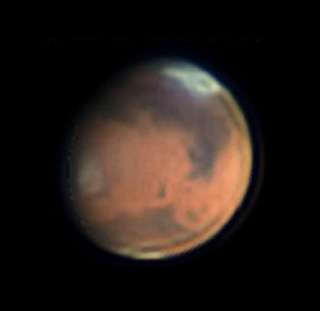
Gibbous Mars on February 20th, imaged byChristopher Go with a 14-inch scope when the planet was still only 7.9 arcseconds from pole to pole. South is up. The big white patch at top is not the South Polar Cap or Cloud Hood but the Hellas basin, which often fills with clouds or frost. The now-tiny North Polar cap is at bottom. Syrtis Major is the big dark peninsula right of center. Near the sunset terminator, thin clouds hide part of Elysium. The dark arc just inside the entire bright limb is an imaging artifact; watch out for these in planetary images.
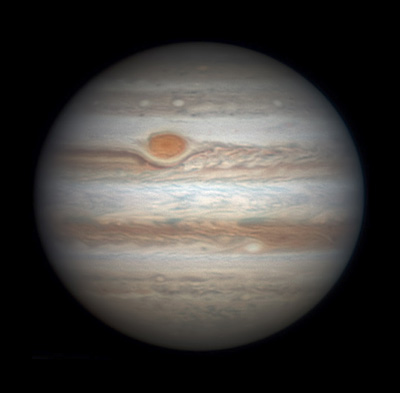
On February 20th Jupiter's Great Red Spot was still strikingly red, as seen in this image by Christopher Go. South is up. Notice the difference in the South Equatorial Belt preceding (left; celestial west) and following the Red Spot, and the white ovals just south of it in the South Temperate Belt like a pair of eyes. How long will it be until winds move them elsewhere?
Mercury is disappearing low into the glow of sunrise. (It's 7° to 9° lower left of Venus.)
Venus (magnitude –3.9) is just above the east-southeast horizon 20 or 30 minutes before sunrise.
Mars (magnitude +0.3, in Libra), rises around midnight and glows yellow-orange in the south before dawn. In a telescope it's 8½ arcseconds in diameter. Mars will appear more than twice as large, 18.6 arcseconds wide, when closest to Earth in late May and early June.
Jupiter (magnitude –2.5, by the hind foot of Leo) is nearing its March 8th opposition. It rises in the east in twilight, shines highest in the south around midnight or 1 a.m., and by dawn it's low in the west. See our telescopic guide to Jupiter in the March Sky & Telescope, page 48.
Saturn (magnitude +0.5, in the feet of Ophiuchus) rises around 1 or 2 a.m. and glows well up in the south-southeast by the beginning of dawn. It's about 18° east of Mars. Spot Antares 8° or 9° to Saturn's lower right.
Uranus (magnitude +5.9, in Pisces) sinks away in the west soon after dark.
Neptune is hidden in conjunction with the Sun.
No comments:
Post a Comment